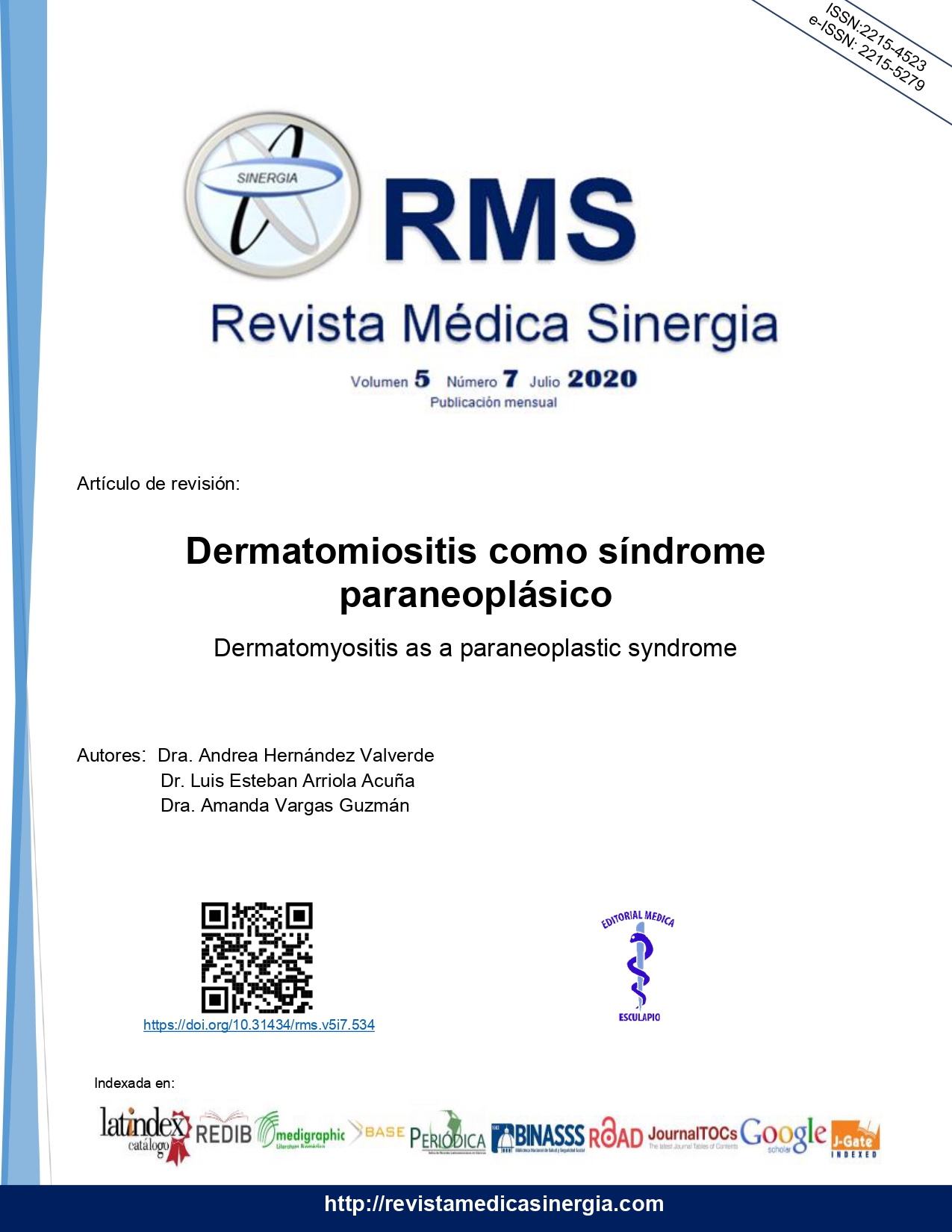Abstract
Inflammatory myopathies have an increased risk of malignancy, the one with the highest association being dermatomyositis. The neoplasm can be solid or hematologic. There are clinical and laboratory factors that can increase or decrease the risk for the presentation of a myositis as a paraneoplastic disease. Among the main risk factors, the presence of anti-TIF1, anti-NXP2 and to a lesser extent anti-SAE antibodies have been observed. The main theory of its origin points to the immune response derived from the creation of mutated proteins by cancer cells. The diagnosis of malignancy can be made before, during or after the diagnosis of dermatomyositis. There is no established therapeutic regimen, however the use of steroids, immunosuppressants or immunoglobulins have been proposed, as well as effective cancer therapy.
Keywords
References
Sasaki H. Kohsaka H. Current diagnosis and treatment of polymyositis and dermatomyositis. Mod Rheumatol. 2018;28(6):913-921. https://doi.org/10.1080/14397595.2018.1467257
Schmidt J. Current Classification and Management of Inflammatory Myopathies. J Neuromuscul Dis. 2018;5(2):109-129. https://doi.org/10.3233/JND-180308
Thompson C, Piguet V, Choy E. The Pathogenesis of Dermatomyositis. Br J Dermatol. 2018;179(6):1233-1234. https://doi.org/10.1111/bjd.15607
Jakubaszek M, Kwiatkowska B, Maślińska M. Polymyositis and dermatomyositis as a risk of developing cancer. Reumatología. 2015;53(2):101-105. https://doi.org/10.5114/reum.2015.51510
Sato S, Kuwana M. Utility of dermatomyositis-specific autoantibodies for diagnosis and clinical subsetting. Int J Clin Rheumatol. 2015;10(4):257-271.
Findlay A, Goyal N, Mozaffar T. An Overview of Polymyositis and Dermatomyositis. Muscle Nerve. 2015;51(5):638-656. https://doi.org/10.1002/mus.24566
Zerdes I, Tolia M, Nikolaou M, Tsoukalas N, Velentza L, Hajiioannou J, et al. How can we effectively address the paraneoplastic dermatomyositis: Diagnosis, risk factors and treatment options. J BUON. 2017;22(4):1073-80.
Fang Y, Jan Y, Kuo C, Luo S, Yu K. Malignancy in dermatomyositis and polymyositis: analysis of 192 patients. Clin Rheumatol. 2016;35(8):1977-1984. https://doi.org/10.1007/s10067-016-3296-8.
Leatham H, Schadt C, Chisolm S, Fretwell D, Chung L, et al. Evidence supports blind screening for internal malignancy in dematomyositis: data from 2 large US dermatology cohorts. Medicine. 2018 enero: 96(3):e9639. http://dx.doi.org/10.1097/MD.0000000000009639
Tiniakou E, Mammen AL. Idiopathic inflammatory myopathies and malignancy: a comprehensive review. Clin Rev Allergy Immunol. 2017;52(1):20-33. https://doi.org/10.1007/s12016-015-8511-x
Shah AA, Casciola‐Rosen L, Rosen A. Cancer‐induced autoimmunity in the rheumatic diseases. Arthritis Rheumatol. 2015;67(2):317-326. https://doi.org/10.1002/art.3892
DeWane ME, Waldman R, Lu J. Dermatomyositis: Clinical features and pathogenesis. J Am Acad Dermatol. 2020;82(2):267-281. https://doi.org/10.1016/j.jaad.2019.06.1309
Motomura K, Yamashita H, Yamada S, Takahashi Y, Kaneko H. Clinical characteristics and prognosis of polymyositis and dermatomyositis associated with malignancy: a 25-year retrospective study. Rheumatol Int. 2019;39(10),1733-1739. https://doi.org/10.1007/s00296-019-04428-z
Cassius C, Le Buanec H, Bouaziz JD, Amode R. Biomarkers in adult dermatomyositis: tools to help the diagnosis and predict the clinical outcome. J Immunol Res. 2019 Jan 14;2019:9141420. https://doi.org/10.1155/2019/9141420
Uruha A, Suzuki S, Nishino I. Diagnosis of dermatomyositis: Autoantibody profile and muscle pathology. Clin Exp Neuroimmunol. 2017;8(4):302-312. https://doi.org/10.1111/cen3.12419
Aussy A, Boyer O, Cordel N. Dermatomyositis and immune-mediated necrotizing myopathies: a window on autoimmunity and cancer. Front Immunol. 2017;8:992. https://doi.org/10.3389/fimmu.2017.0099
Yang WM, Chen JJ. Advances in biomarkers for dermatomyositis. Clin Chim Acta. 2018;482:172-177. https://doi.org/10.1016/j.cca.2018.03.042
Yang H, Peng Q, Yin L, Li S, Shi J, Zhang Y, et al. Identification of multiple cancer-associated myositis-specific autoantibodies in idiopathic inflammatory myopathies: a large longitudinal cohort study. Arthritis Res Ther. 2017;19(1):259. https://doi.org/10.1186/s13075-017-1469-8
Aussy A, Fréret M, Gallay L, Bessis D, Vincent T, Jullien D, et al. The IgG2 Isotype of Anti–Transcription Intermediary Factor 1γ Autoantibodies Is a Biomarker of Cancer and Mortality in Adult Dermatomyositis. Arthritis Rheumatol. 2019;71(8):1360-1370. https://doi.org/10.1002/art.40895
Fujimoto M, Watanabe R, Ishitsuka Y, Okiyama N. Recent advances in dermatomyositis-specific autoantibodies. Curr Opin Rheumatol. 2016;28(6):636-644. https://doi.org/10.1097/BOR.0000000000000329
Merlo G, Clapasson A, Cozzani E, Sanna L, Pesce G, Bagnasco M, et al. Specific autoantibodies in dermatomyositis: a helpful tool to classify different clinical subsets. Arch Dermatol Res. 2017;309(2):87-95. https://doi.org/10.1007/s00403-016-1704-1
Wolstencroft PW, Fiorentino DF. Dermatomyositis clinical and pathological phenotypes associated with myositis-specific autoantibodies. Curr Rheumatol Rep. 2018;20(5):28. https://doi.org/10.1007/s11926-018-0733-5
Ogawa-Momohara M, Muro Y, Mitsuma T, Katayama M, Yanaba K, Nara M, et al. Strong correlation between cancer progression and anti-transcription intermediary factor 1γ antibodies in dermatomyositis patients. Clin Exp Rheumatol. 2018;36(6):990-995.
Albayda J, Pinal-Fernandez I, Huang W, Parks C, Paik J, Casciola-Rosen L, et al. Dermatomyositis patients with anti-nuclear matrix protein-2 autoantibodies have more edema, more severe muscle disease, and increased malignancy risk. Arthritis Care Res. 2017;69(11):1771. https://doi.org/10.1002/acr.23188
Rogers A, Chung L, Li S, Casciola‐Rosen L, Fiorentino DF. Cutaneous and systemic findings associated with nuclear matrix protein 2 antibodies in adult dermatomyositis patients. Arthritis Care Res. 2017;69(12):1909-1914. https://doi.org/10.1002/acr.23210
Liu Y, Xu L, Wu H, Zhao N, Tang Y, Li X, et al. Characteristics and predictors of malignancy in dermatomyositis: Analysis of 239 patients from northern China. Oncol Lett. 2018;16(5):5960-5968. https://doi.org/10.3892/ol.2018.9409
Hoesly PM, Sluzevich JC, Jambusaria-Pahlajani A, Lesser ER, Heckman MG, Abril A. Association of antinuclear antibody status with clinical features and malignancy risk in adult-onset dermatomyositis. J Am Acad Dermatol. 2019;80(5):1364-1370. https://doi.org/10.1016/j.jaad.2018.11.023
Selva A, Ros J, Gil A, Vila G, Trallero E, Pinal I. Malignancy and Myositis, from molecular mimicry to tumor infiltrating lymphocytes. Neuromuscul Disord. 2019;29(11):819-825. https://doi.org/10.1016/j.nmd.2019.09.014
McHugh N, Tansley S. Autoantibodies in myositis. Nat Rev Rheumatol. 2018;14(5):290-302. https://doi.org/10.1038/nrrheum.2018.56
Bogdanov I, Kazandjieva J, Darlenski R, Tsankov N. Dermatomyositis: current concepts. Clin Dermatol. 2018;36(4):450-458. https://doi.org/10.1016/j.clindermatol.2018.04.003
Oldroyd A, Sergeant JC, New P, McHugh NJ, Betteridge Z, Lamb JA, et al. The temporal relationship between cancer and adult onset anti-transcriptional intermediary factor 1 antibody–positive dermatomyositis. Rheumatology. 2019;58(4):650-655. https://doi.org/10.1093/rheumatology/key357
Waldman R, DeWane ME, Lu J. Dermatomyositis: Diagnosis and treatment. J Am Acad Dermatol. 2020;82(2): 283-296. https://doi.org/10.1016/j.jaad.2019.05.105
Sellami K, Mseddi M, Snoussi M, Gharbi H, Frikha F, Ben R, et al. Malignancy in a retrospective cohort of 17 patients with Dermatomyositis or Polymyositis in southern Tunisia. Rom J Intern Med. 2018;56(4):243-249. https://doi.org/10.2478/rjim-2018-0015


